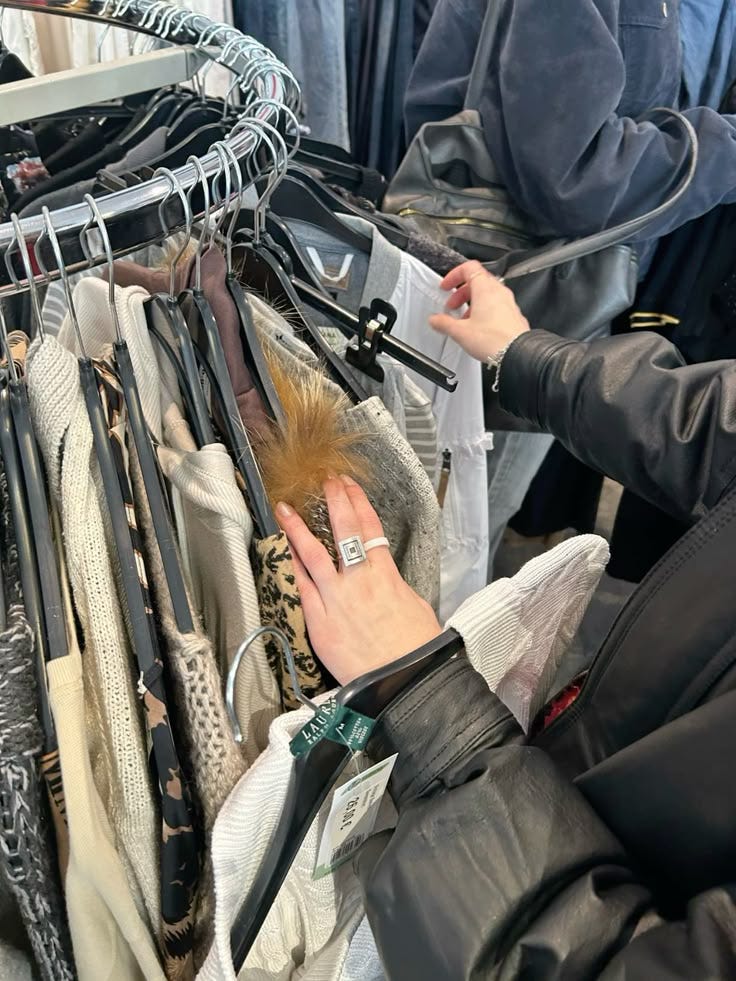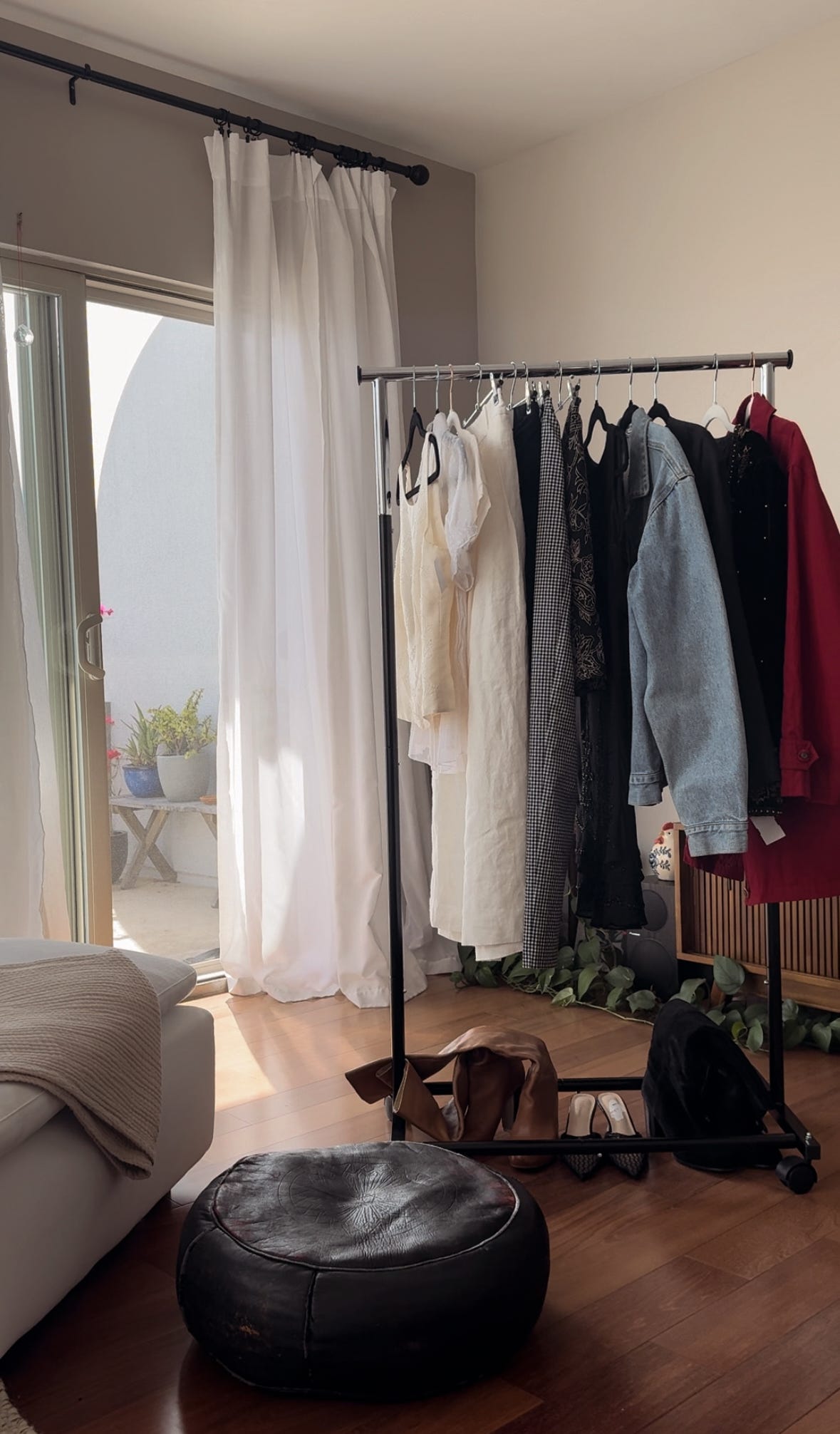Thrifting is more than just a way to save money (although that’s my favorite part)—it’s an art form, a treasure hunt, and a chance to curate a wardrobe that’s uniquely yours.
I joke that thrifting has become my new favorite hobby. But I’ll tell you, a good podcast episode in your airpods as you sift through the many racks & day dream up cute outfits? It’s pretty blissful.
But beyond the creative and financial pros, the most obvious benefit is the impact on the environment.
The fashion industry is responsible for approximately 10% of global carbon dioxide emissions, surpassing the combined emissions from international flights and maritime shipping. Additionally, it consumes around 79 trillion liters of water annually, making it the second most water-intensive industry worldwide. This overconsumption has led to an estimated 92 million tons of clothing-related waste being discarded each year. By choosing to thrift, you not only find unique pieces but also play a part in reducing this environmental footprint.
But, let’s be really real for a second. Walking into a thrift store for the first time (or even the tenth) can feel overwhelming. The racks are packed, the organization is questionable, and the sheer volume of choices can leave you feeling lost.
But don’t worry! With a little strategy, patience, and intuition, you can master the art of secondhand shopping. Here are my seven tried-and-true tips to help you thrift like a pro.
1. Go In with a (Visual) Plan
Y’all know by now—I’ll never deny myself the chance to make a Pinterest board, and thrifting is the perfect excuse to create (another) one. I titled mine: “May the thrift guides find me this…” and I add different pins featuring pieces I’m really hoping to find.
Sometimes, the thrift gods work fast, and I find exactly what I want on my next trip. Other times, it's a slow and steady manifestation—I've come across pieces six months after pinning them that look and feel identical to my vision. Another example of divine timing at work.
Before heading out for your first trip to the store, gather at least 10-15 Pins with outfit inspiration or looks you’d love to recreate. This becomes your thrift map, helping you focus on silhouettes, colors, and key pieces that actually align with your style.
2. Tackle 2-3 Sections Rather Than the Whole Store
Thrift stores can feel chaotic, especially for beginners. Instead of trying to conquer the entire store, focus on two or three sections. Maybe it’s blazers and denim, or dresses and handbags. Sticking to just a few areas makes the experience more manageable and helps you get familiar with how the store is organized.
And remember—your chosen sections should align with the board you created!
Bonus Tip: Keep it Simple and Seasonal. Shopping in alignment with the season will naturally narrow your focus. You probably don’t need a heavy coat in July or sandals in December, so prioritize what you'll actually wear right now.
3. Feel for Good Fabrics
Thrift store racks are the Wild West of fashion—high-quality vintage gems mixed right in with fast fashion that barely survived a season. The secret? Feel the fabric.
Run your hands along the racks and notice how different materials feel. Natural fibers like cotton, wool, linen, and silk will last longer and wear better than synthetic ones. One of my favorite things about thrifting is how it reconnects you with how clothes used to be made (sigh). You’ll quickly realize how much of today’s clothing is non-breathable, plastic-y, and made to fall apart fast.
Choosing quality pieces ensures your thrift finds actually last—and keeps the sustainability piece of secondhand shopping intentional.
4. Consider Your Colors
Before thrifting, take a moment to assess your closet. What colors do you naturally gravitate toward?
If you already wear a lot of blue, chances are you’ll actually wear a blue thrift find. For me, I realized I don’t own many pastels or beige tones—I stick to black, white, and rich jewel tones like reds and deep blues. Knowing your color palette helps you avoid impulse buys that won’t fit in with the rest of your wardrobe.
And here’s a huge thrift hack—most thrift stores organize racks by color, not size. This means you can skip entire sections that don’t align with your color scheme, making shopping way more efficient. The same trick applies to patterns. I love stripes but skip florals, so I immediately know what’s worth pulling off the rack.
5. Edit Down Before You Buy
Don’t fall into the dopamine-buy trap. Just because something is inexpensive and unique doesn’t mean you actually need it.
Before heading to the checkout, find a quiet corner and do a final edit of your haul.
Inspect each item for stains, tears, or missing buttons.
Ask yourself: If I brought this home today, could I wear it tomorrow? (After washing, of course!)
Do you already own the right shoes, jackets, or bottoms to make an outfit with it? If not, reconsider.
The goal is to build a versatile, interchangeable wardrobe—not just collect random statement pieces you don’t know how to style.
6. Trust Your Energy. If Something Feels Off, Pass on It.
Here’s where my psychic insight comes in.
Sometimes, an item looks perfect, fits great, and is an absolute steal—yet it just feels off.
Trust that feeling.
Clothing carries energy. If something feels heavy—like it’s been through difficult moments with its previous owner—it’s okay to leave it behind. The best thrift finds bring a light, easy energy.
If you feel even a little hesitant, put it back. You’ll find something better.
7. Check the End Caps and Fitting Room Areas
This is a little thrift hack that never fails me.
Always take a peek at the racks near the fitting rooms and end caps of aisles. These are where people leave their “maybes” or put back pieces they loved but didn’t end up buying. Sometimes, it’s like stumbling upon a curated mini collection from someone with similar taste and size.
When I find a particularly good pile of pre-vetted pieces, I mentally thank my fellow thrifter and hope they found exactly what they were looking for.
Thrifting is an Exchange—And It Gets Easier with Practice
There’s a unique exchange happening in every thrift store.
Items pass through different hands, shifting lives in the process—literally. I’ve watched women of all ages cheer each other on as they find the perfect coat or hype up a total stranger in the fitting room. It’s a beautiful little economy of encouragement.
And here’s the thing—thrifting is a skill that gets easier (and more fun) with practice. The more you do it, the better you’ll get at spotting quality, editing your finds, and trusting your intuition.
So whether you're building a capsule wardrobe, hunting for unique vintage pieces, or searching for decor treasures, don’t overthink it. The beauty of thrifting is that it’s less wasteful, more intentional, and way more fun than shopping new.
And listen—you’re going to bring home something that makes you say, “What was I thinking?!?!” when you unpack your haul.
It’s fine. My friend calls it having Goodwill glasses—that little thrift-induced euphoria where everything looks better than it actually is.
When that happens? Just re-donate it, laugh it off, and keep having fun.
And because I love a good thrift haul, I’m sharing one with you.
And because I love seeing a good thrift haul, I’m sharing one with you. Here are some of my favorite pieces I found this season plus ideas of how I'll be styling them. Scroll down for outfit ideas and a peek at the secondhand gems that made the cut in my recent trips to the thrift.
Keep reading with a 7-day free trial
Subscribe to Intuitive Living with Kate Van Horn to keep reading this post and get 7 days of free access to the full post archives.






